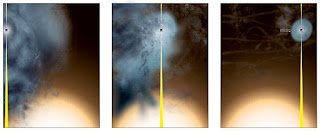 |
| Artist's conception of how the "nearly naked" supermassive black hole originated. Credit: Bill Saxton, NRAO/AUI/NSF. |
Topics: Astronomy, Astrophysics, Black Holes, Cosmology
Astronomers using the super-sharp radio vision of the National Science Foundation's Very Long Baseline Array (VLBA) have found the shredded remains of a galaxy that passed through a larger galaxy, leaving only the smaller galaxy's nearly-naked supermassive black hole to emerge and speed away at more than 2,000 miles per second.
The galaxies are part of a cluster of galaxies more than 2 billion light-years from Earth. The close encounter, millions of years ago, stripped the smaller galaxy of nearly all its stars and gas. What remains is its black hole and a small galactic remnant only about 3,000 light-years across. For comparison, our Milky Way Galaxy is approximately 100,000 light-years across.
The discovery was made as part of a program to detect supermassive black holes, millions or billions of times more massive than the Sun, that are not at the centers of galaxies. Supermassive black holes reside at the centers of most galaxies. Large galaxies are thought to grow by devouring smaller companions. In such cases, the black holes of both are expected to orbit each other, eventually merging.
National Radio Astronomy Observatory:
Close Galactic Encounter Leaves "Nearly Naked" Supermassive Black Hole
Dave Finley, Public Information Officer
Comments